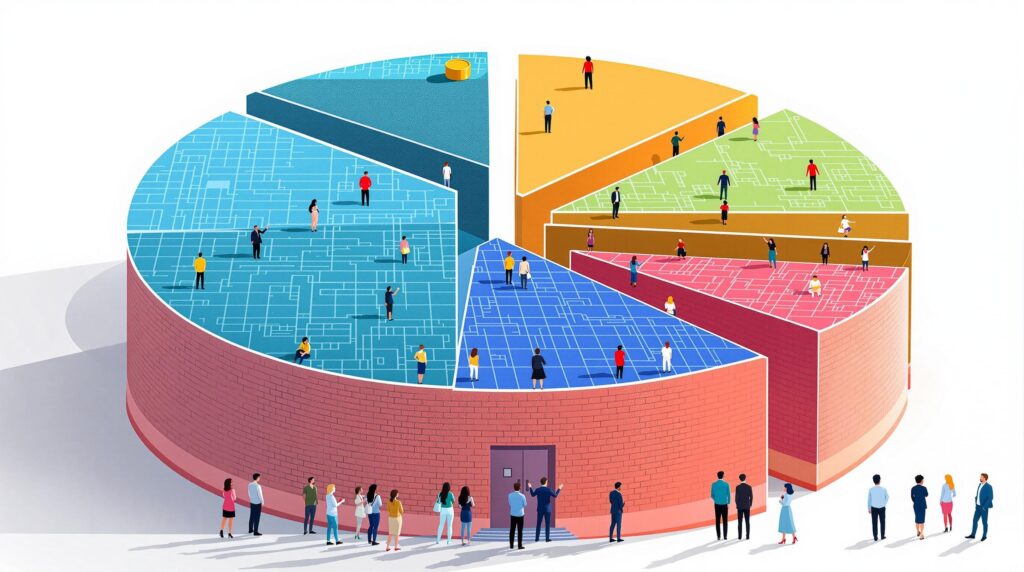[rev_slider alias=”slider-1″][/rev_slider]
Introduction to Layer 1 Blockchains
Layer 1 blockchains are the bedrock of decentralized networks, laying the groundwork for a new era of digital transformation. But what exactly is a Layer 1 blockchain? Picture it as the main highway that supports countless vehicles, each carrying its own unique packets of information. These blockchains are independent, with their own consensus mechanisms and decentralized architectures.
Unlike Layer 2 solutions that build on top of existing protocols to enhance scalability and efficiency, Layer 1 blockchains operate independently and are responsible for the core set of rules and validations that keep the network secure and decentralized. From facilitating peer-to-peer transactions to housing smart contracts, these systems are the backbone of the entire blockchain ecosystem.
Currently, the African digital landscape is experiencing a rapid transformation, driven by the integration of Layer 1 blockchains. This is not just about cryptocurrency; it’s about embracing a broader system of financial inclusion and empowerment. In regions with limited access to traditional financial services, these chains democratize access, providing secure, efficient, and scalable solutions for conducting transactions.
Importance in Decentralization
So, why are Layer 1 blockchains crucial in decentralization? In essence, they offer the foundational infrastructure that supports not just cryptocurrency, but a range of decentralized applications (dApps) and services that can operate without a central authority. These platforms ensure transparency and security in an otherwise opaque digital world.
What is the role of Layer 1 blockchains in decentralization? Layer 1 blockchains provide the foundational network architecture that enables decentralized operations by securing transactions and facilitating consensus without central intermediaries.
Moreover, the decentralized nature of Layer 1 blockchains like Jara’s own Caldera-based infrastructure ensures that power is distributed among participants. This shifts control from centralized entities to individual users, fostering an environment of trust and reducing the risk of single points of failure. Imagine it as a community marketplace where each stallholder keeps his own records and transactions, immune to any central authority that might impose extra fees or dictate the terms arbitrarily.
Africa presents a unique opportunity where the high potential of digital infrastructure remains largely untapped. By embracing decentralized solutions, countries within the continent can leap over traditional barriers to development, unlocking new avenues for growth and innovation. Layer 1 blockchains are not just technological solutions; they are engines powering the continent’s future, fueling the aspirations of millions by providing a robust and secure digital economy.
In conclusion, while the concept of Layer 1 blockchains might seem complex, their impact on decentralization and blockchain technology at large is monumental. As Africa embraces this digital transformation, the potential for economic empowerment, equity, and innovation through Layer 1 solutions becomes clearer. Whether you’re investing in cryptocurrency or exploring new business opportunities, understanding the role of these blockchains is key to participating in this transformative journey.
Leading Layer 1 Blockchain Platforms
In the rapidly evolving world of blockchain technology, Layer 1 blockchains stand out as the foundational networks that support decentralized ecosystems. Among these platforms, Ethereum, Binance Smart Chain, and Solana have emerged as frontrunners, each offering unique features that contribute to the overarching vision of decentralization. These platforms are not only leading the future but are also pivotal in shaping how digital assets are managed, traded, and utilized across various sectors worldwide.
What are Layer 1 blockchains? Layer 1 blockchains are the base networks in a crypto-economy that manage transactions and record them in a decentralized manner, aiming to provide security, scalability, and decentralized control.
Comparison of Features
While Ethereum, Binance Smart Chain, and Solana share the common goal of advancing decentralized technology, they differ significantly in their approaches and capabilities. Let’s delve into a comparative analysis of these platforms to understand their distinct features and contributions:
- Ethereum: Known as the pioneer of smart contracts, Ethereum’s expansive ecosystem supports decentralized applications (dApps) across the globe. Its recent upgrade to Ethereum 2.0 aims to solve issues related to scalability and gas fees by transitioning to a proof-of-stake model.
- Binance Smart Chain (BSC): BSC is renowned for its low transaction fees and high throughput, making it an attractive option for developers looking to build cost-efficient dApps. By maintaining compatibility with Ethereum Virtual Machine (EVM), it enables easy migration for activities within Ethereum’s network.
- Solana: Solana boasts one of the fastest transaction speeds in the blockchain space, with its unique proof-of-history mechanism providing tremendous scalability potential. This feature makes Solana especially appealing for high-frequency trading and real-time applications.
Each of these platforms has carved a niche by focusing on different aspects of blockchain utility and performance. Their varying strengths in areas such as developer ecosystems, transaction efficiency, and technological innovation collectively shape the future landscape of blockchain technology.
“Ethereum’s comprehensive ecosystem, Binance Smart Chain’s cost-efficiency, and Solana’s speed represent a trifecta of innovation driving the next wave of blockchain adoption worldwide.”
Exploring these platforms further reveals intriguing insights into how each is positioned to address core blockchain challenges like scalability and interoperability. As Africa continues to embrace digital advancements, these Layer 1 blockchains might just be the linchpin of economic transformation, powered by solutions like the Jara ecosystem.
The African blockchain scene is thrillingly poised to leverage these advancements, given, for example, Jara’s commitment to embedding Layer 2 solutions within its infrastructure for practical and seamless financial transformations. As we move deeper into this decentralized era, understanding these foundational platforms becomes increasingly crucial for stakeholders and investors alike.
Investing in platforms like Ethereum, Binance Smart Chain, and Solana now may well mean placing a bet not just on the future of technology, but on the democratization of finance.
[rev_slider alias=”text-call-cta”][/rev_slider]
Innovation in Layer 2 Blockchain Solutions
Layer 2 blockchain solutions represent a critical step forward in addressing some of the biggest challenges faced by Layer 1 blockchains, such as Bitcoin and Ethereum. Known for their scalability issues and high transaction costs, these Layer 1 protocols set the groundwork but need enhancements to meet the growing demands of the digital age. Enter Layer 2 solutions—a technological marvel designed to significantly improve efficiency and scalability.
What are Layer 2 blockchain solutions? They are protocols that run on top of Layer 1 blockchains to enhance scalability and efficiency, reducing costs and increasing transaction speeds.
The beauty of Layer 2 lies in its ability to offload transactions from the main chain, thereby reducing congestion. Imagine a busy highway; the main blockchain is like this highway, and without additional lanes, traffic becomes unbearable. Layer 2 acts like those auxiliary lanes, easing congestion and allowing for a smoother traffic flow. This innovation means that users can perform faster transactions at a fraction of the cost, making blockchain technology more practical for everyday use.
Case Studies of Success
To truly understand the impact of Layer 2 solutions, it’s essential to look at real-world applications that highlight their success and potential. These implementations not only demonstrate enhanced scalability but also drive the blockchain ecosystem’s growth and adoption.
Lightning Network on Bitcoin: The Lightning Network is probably the most well-known Layer 2 solution for Bitcoin. It’s designed to enable faster payments with lower fees by facilitating off-chain transactions. This network has gained substantial traction, proving that Bitcoin can indeed handle the scale required for global finance.
Another powerful example comes from the Optimistic Rollups used in the Ethereum ecosystem. This approach allows for massive scaling, without sacrificing the decentralized nature of the blockchain. It’s an exciting development, especially considering Ethereum’s goal of transitioning to Ethereum 2.0.
Success in Layer 2 implementations: The Lightning Network and Optimistic Rollups have set benchmarks in scalability and efficiency for Bitcoin and Ethereum, respectively.
The Jara ecosystem is another fascinating pathway. Jara’s proprietary Layer 2 blockchain infrastructure demonstrates the potential of Layer 2 solutions in tokenizing real-world assets within Africa’s digital economy. This application empowers financial inclusion and economic empowerment by bridging global capital to African assets, as showcased through their recent Lagos airport tokenization project.
These examples reflect how Layer 2 solutions are not only solving current issues but also unlocking new potential across various markets. By reducing transaction costs and increasing processing speeds, Layer 2 innovations are paving the way for broader blockchain adoption. This rapid adoption propels the Jara mission of transforming Africa’s digital landscape, further emphasizing the significance of Layer 2 solutions.
The future of blockchain lies in Layer 2 advancements and their ability to support a sustainable, efficient, and scalable network. This technology marks a transformative shift for industries and individuals alike, forging a path for further decentralization and financial inclusivity.
Future Trends in Blockchain Decentralization
The world of blockchain is dynamic and ever-evolving, with decentralization at its core. As we survey the landscape, several emerging trends in blockchain decentralization stand out. These significant shifts in technology and strategy are expected to shape both Layer 1 and Layer 2 blockchain solutions, influencing how these systems integrate with global economies and industries, particularly in Africa.
Scalability and Interoperability
One of the key challenges for the future of blockchain decentralization is scalability. As more transactions are processed, the demand for efficient and scalable solutions becomes critical. Layer 1 blockchains, like Ethereum and Bitcoin, are addressing these concerns by upgrading their protocols. For instance, Ethereum’s transition towards Ethereum 2.0 promises enhanced scalability through sharding.
What is Sharding in Blockchain? Sharding is a process of splitting a blockchain into smaller pieces, called ‘shards’, which distribute the network’s workload to improve scalability and transactions per second (TPS).
On the other hand, interoperability remains a driving force for connecting diverse blockchain ecosystems. Cross-chain solutions are emerging, allowing different blockchains to communicate and transact seamlessly. This trend supports a more interconnected decentralized financial system, fostering innovation and collaboration.
Decentralized Finance (DeFi) Expansion
The rise of Decentralized Finance (DeFi) represents one of the most transformative trends in the blockchain space. By eliminating traditional gatekeepers and using smart contracts, DeFi opens unprecedented access to financial services. This is particularly impactful for regions like Africa, where financial inclusion is a pressing need.
With DeFi’s growth, we’re seeing innovative products such as decentralized exchanges (DEXs), lending platforms, and yield farming becoming mainstream. These developments not only democratize access to financial instruments but also encourage a more robust ecosystem around digital assets.
Privacy and Security Enhancements
As blockchain systems evolve, so too do the concerns around privacy and security. Emerging technologies aim to enhance user anonymity while securing transactions. Zero-knowledge proofs are leading the charge, allowing verification of information without revealing the information itself. This technology is particularly useful in ensuring confidentiality in transactions without compromising transparency.
What are Zero-Knowledge Proofs? A zero-knowledge proof is a cryptographic method by which one party can prove to another party that a statement is true, without revealing any additional information.
Moreover, advancements in cryptographic algorithms continue to fortify blockchain networks, safeguarding against potential attacks and ensuring the integrity of data.
Challenges and Opportunities
While the future of blockchain decentralization is promising, it is not without its challenges. One significant barrier to Layer 1 blockchain adoption is regulatory uncertainty. As governments around the world look to understand and regulate cryptocurrencies, blockchain networks must navigate a complex legal landscape. In Africa, where regulatory frameworks are still forming, this presents both a challenge and an opportunity for growth and innovation.
Another challenge is the technological infrastructure required to support these decentralized systems. Many regions still lack the necessary digital infrastructure to fully leverage blockchain technology. However, initiatives like Jara’s $JARA token ecosystem are paving the way for robust platforms that can bridge these gaps, providing access to a global capital market and enhancing financial inclusion.
Opportunities for growth abound, particularly in regions with untapped potential for digital transformation. By focusing on inclusivity and leveraging innovations, Africa is poised to lead the charge in blockchain adoption. For instance, tokenization projects like those supported by Jara—such as the Lagos airport tokenization—demonstrate the capacity for real-world asset integration within blockchain frameworks, driving economic empowerment.
“Invest in $JARA today and become part of Africa’s digital future.” – Join the robust ecosystem connecting global capital with Africa’s burgeoning markets.
The fusion of technological innovation with strategic partnerships, such as those cultivated by Jara, offers a blueprint for harnessing blockchain’s full potential. As the local and global communities continue to adapt and evolve, the pathways opened by these trends promise a decentralized future poised for growth.
[rev_slider alias=”schedule-consultation-btn”][/rev_slider]

What distinguishes Layer 1 from Layer 2 blockchain solutions?
Layer 1 blockchain solutions refer to the primary network that forms the foundational architecture of a blockchain environment. In contrast, Layer 2 solutions are additional frameworks or protocols designed to operate on top of Layer 1 blockchains to enhance and scale their capabilities. Key distinctions include:
- Infrastructure: Layer 1 is the main network, while Layer 2 runs as an overlay.
- Scalability: Layer 2 enhances transaction speed and throughput.
- Use cases: Layer 1 is versatile; Layer 2 is typically application-specific.
How do Layer 1 blockchains support decentralization?
Layer 1 blockchains support decentralization by establishing a trustless environment where all participants can interact without a central authority. They accomplish this through methods such as:
- Distributed ledger technology ensuring data transparency and immutability.
- Consensus mechanisms like Proof of Work (PoW) or Proof of Stake (PoS) that prevent double-spending.
- Autonomous smart contract execution that enforces decentralized governance.
Can Layer 2 solutions operate without Layer 1 blockchains?
Layer 2 solutions cannot operate independently without Layer 1 blockchains. They rely on the security, data integrity, and consensus mechanisms provided by Layer 1 to function effectively. Essentially, Layer 2 solutions exist to offload processes from Layer 1, facilitating faster transactions and reducing congestion.
What future trends are anticipated for Layer 1 blockchain technology?
Future trends for Layer 1 blockchain technology focus on enhancing scalability, interoperability, and security. Important trends include:
- Sharding: Increasing transaction throughput by dividing network nodes into smaller sections.
- Interoperability protocols: Enabling seamless interaction between different blockchains.
- Advanced consensus algorithms: Developing more energy-efficient and faster consensus processes.

Related Practice Areas
Explore other related pages that complement our focus on Layer 1 blockchains and decentralization.
| Crypto Security CITY | Smart Contracts CITY |
| Decentralized Finance CITY | Blockchain Compliance CITY |
| Digital Asset Management CITY | Tokenomics CITY |
| Initial Coin Offerings CITY | Blockchain Consultation CITY |
Discover What Our Clients Are Saying
At the forefront of our Layer 1 and Layer 2 blockchain solutions practice is a deep-seated commitment to client satisfaction. Each case is handled with utmost care, as echoed in the appreciative feedback from those we represent.

[rev_slider alias=”slider-3″][/rev_slider]
[rev_slider alias=”slider-6″][/rev_slider]
Discover the Leaders in Blockchain Decentralization
Are you ready to explore the forefront of blockchain innovation? Jara is dedicated to bridging global capital to African assets, positioning itself as a leader in both Layer 1 and Layer 2 blockchain solutions.
“Your Voice, Our Mission” – we champion transformative blockchain solutions with the tenacity and dedication that has earned us recognition across the industry.
But don’t just take our word for it. Recognized as a key player, we have been proudly listed in these prestigious awards for our blockchain expertise:
- Highlighted among the “Top Blockchain Innovators of 2023” by Blockchain Excellence, recognizing our groundbreaking contributions to decentralization innovation. Learn more
- Named as one of the “Best Layer 1 Solutions Providers in Africa” for 2023 by TechAfrica, for our unwavering commitment to enhancing scalability and security. Explore this recognition
- Recognized among the “Leading Blockchain Platforms Transforming Finance” 2023 by FinTech Elite, validating our innovative approach in financial ecosystems. Discover our success
- Listed in the “Top 10 Driving Decentralization Specializations” of 2023 by Decentral Magazine, highlighting our strategic role in evolving decentralized networks. See our impact
- Showcased among the “Premier Blockchain Solutions Experts” for 2023 by Global Tech Review for setting new standards in blockchain technology application. Read more
Join us at Jara to navigate the future of blockchain technology together. Download the Jara app today from Google Play or the App Store and begin your journey to decentralization.
Chinyere “Chi” Nnadi Bio
Founder and CEO, Jara | Blockchain Specialist
Content Reviewed by Chi Nnadi and his Content Team. Chi is an experienced entrepreneur dedicated to transforming Africa’s financial ecosystem through blockchain technology. As Founder and CEO of Jara, he builds enterprise-grade infrastructure converting illiquid African assets into globally accessible digital tokens. With his proprietary Layer-2 blockchain technology, Chi bridges the gap between global investors and Africa’s growing digital asset market.
Our Content Review Process
Chi Nnadi along with Jara’s dedicated content team, pledge to offer top-notch material. Our content guidelines ensure thoroughness, reputable sources, unbiased scrutiny, among other quality metrics. Please let us know if there is anything you believe to be inaccurate.
















